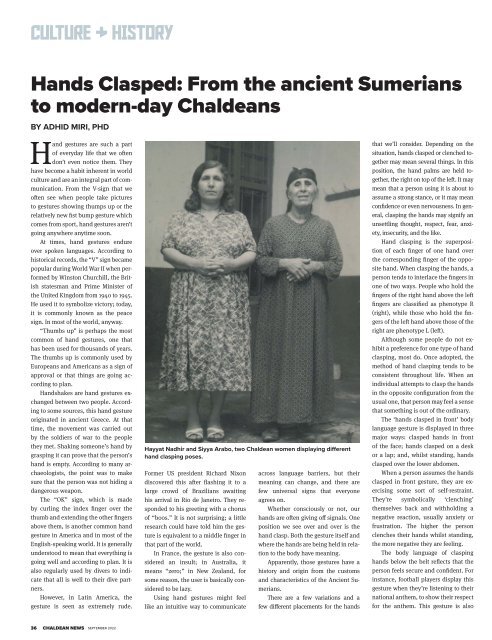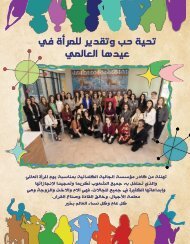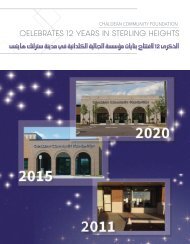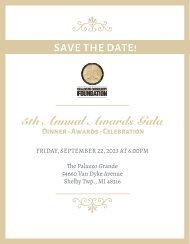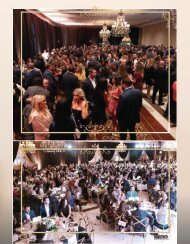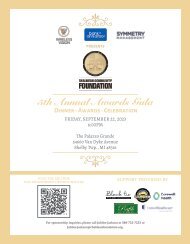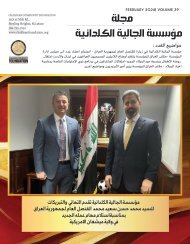Create successful ePaper yourself
Turn your PDF publications into a flip-book with our unique Google optimized e-Paper software.
CULTURE & HISTORY<br />
Hands Clasped: From the ancient Sumerians<br />
to modern-day Chaldeans<br />
BY ADHID MIRI, PHD<br />
Hand gestures are such a part<br />
of everyday life that we often<br />
don’t even notice them. They<br />
have become a habit inherent in world<br />
culture and are an integral part of communication.<br />
From the V-sign that we<br />
often see when people take pictures<br />
to gestures showing thumps up or the<br />
relatively new fist bump gesture which<br />
comes from sport, hand gestures aren’t<br />
going anywhere anytime soon.<br />
At times, hand gestures endure<br />
over spoken languages. According to<br />
historical records, the “V” sign became<br />
popular during World War II when performed<br />
by Winston Churchill, the British<br />
statesman and Prime Minister of<br />
the United Kingdom from 1940 to 1945.<br />
He used it to symbolize victory; today,<br />
it is commonly known as the peace<br />
sign. In most of the world, anyway.<br />
“Thumbs up” is perhaps the most<br />
common of hand gestures, one that<br />
has been used for thousands of years.<br />
The thumbs up is commonly used by<br />
Europeans and Americans as a sign of<br />
approval or that things are going according<br />
to plan.<br />
Handshakes are hand gestures exchanged<br />
between two people. According<br />
to some sources, this hand gesture<br />
originated in ancient Greece. At that<br />
time, the movement was carried out<br />
by the soldiers of war to the people<br />
they met. Shaking someone’s hand by<br />
grasping it can prove that the person’s<br />
hand is empty. According to many archaeologists,<br />
the point was to make<br />
sure that the person was not hiding a<br />
dangerous weapon.<br />
The “OK” sign, which is made<br />
by curling the index finger over the<br />
thumb and extending the other fingers<br />
above them, is another common hand<br />
gesture in America and in most of the<br />
English-speaking world. It is generally<br />
understood to mean that everything is<br />
going well and according to plan. It is<br />
also regularly used by divers to indicate<br />
that all is well to their dive partners.<br />
However, in Latin America, the<br />
gesture is seen as extremely rude.<br />
Hayyat Nadhir and Siyya Arabo, two Chaldean women displaying different<br />
hand clasping poses.<br />
Former US president Richard Nixon<br />
discovered this after flashing it to a<br />
large crowd of Brazilians awaiting<br />
his arrival in Rio de Janeiro. They responded<br />
to his greeting with a chorus<br />
of “boos.” It is not surprising; a little<br />
research could have told him the gesture<br />
is equivalent to a middle finger in<br />
that part of the world.<br />
In France, the gesture is also considered<br />
an insult; in Australia, it<br />
means “zero;” in New Zealand, for<br />
some reason, the user is basically considered<br />
to be lazy.<br />
Using hand gestures might feel<br />
like an intuitive way to communicate<br />
across language barriers, but their<br />
meaning can change, and there are<br />
few universal signs that everyone<br />
agrees on.<br />
Whether consciously or not, our<br />
hands are often giving off signals. One<br />
position we see over and over is the<br />
hand clasp. Both the gesture itself and<br />
where the hands are being held in relation<br />
to the body have meaning.<br />
Apparently, those gestures have a<br />
history and origin from the customs<br />
and characteristics of the Ancient Sumerians.<br />
There are a few variations and a<br />
few different placements for the hands<br />
that we’ll consider. Depending on the<br />
situation, hands clasped or clenched together<br />
may mean several things. In this<br />
position, the hand palms are held together,<br />
the right on top of the left. It may<br />
mean that a person using it is about to<br />
assume a strong stance, or it may mean<br />
confidence or even nervousness. In general,<br />
clasping the hands may signify an<br />
unsettling thought, respect, fear, anxiety,<br />
insecurity, and the like.<br />
Hand clasping is the superposition<br />
of each finger of one hand over<br />
the corresponding finger of the opposite<br />
hand. When clasping the hands, a<br />
person tends to interlace the fingers in<br />
one of two ways. People who hold the<br />
fingers of the right hand above the left<br />
fingers are classified as phenotype R<br />
(right), while those who hold the fingers<br />
of the left hand above those of the<br />
right are phenotype L (left).<br />
Although some people do not exhibit<br />
a preference for one type of hand<br />
clasping, most do. Once adopted, the<br />
method of hand clasping tends to be<br />
consistent throughout life. When an<br />
individual attempts to clasp the hands<br />
in the opposite configuration from the<br />
usual one, that person may feel a sense<br />
that something is out of the ordinary.<br />
The ‘hands clasped in front’ body<br />
language gesture is displayed in three<br />
major ways: clasped hands in front<br />
of the face; hands clasped on a desk<br />
or a lap; and, whilst standing, hands<br />
clasped over the lower abdomen.<br />
When a person assumes the hands<br />
clasped in front gesture, they are exercising<br />
some sort of self-restraint.<br />
They’re symbolically ‘clenching’<br />
themselves back and withholding a<br />
negative reaction, usually anxiety or<br />
frustration. The higher the person<br />
clenches their hands whilst standing,<br />
the more negative they are feeling.<br />
The body language of clasping<br />
hands below the belt reflects that the<br />
person feels secure and confident. For<br />
instance, football players display this<br />
gesture when they’re listening to their<br />
national anthem, to show their respect<br />
for the anthem. This gesture is also<br />
36 CHALDEAN NEWS <strong>SEPTEMBER</strong> <strong>2022</strong>


